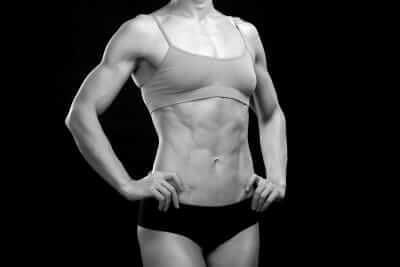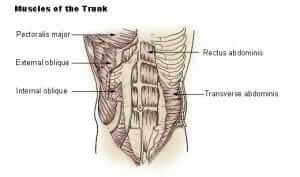How much do you really know about the structure and function of yours abdominal muscles? This short ab-natomy lesson from the author of The Body Sculpting Bible for Abs:Women’s Edition and The Body Sculpting Bible for Abs:Men’s Edition, James Villepigue, will help you understand how your abs work — and how you can sculpt them to their full potential.
Ab-Natomy Class
Knowing something about the different parts of your abdomen and how they work is important. Knowing what muscles you’re training and having a mental picture of how they’re moving as they contract during an exercise helps you form the kind of mind-muscle connection that leads to more productive training.
The abdominals are made up of a few distinct muscle groups that have a variety of different functions:
First is the rectus abdominis, by far the most well-known of the abdominal muscles. It’s the muscle people mean when they talk about a “six pack”. The rectus abdominis starts at the sternum and rib cage and inserts on the pubic bone. The primary job of the muscle is to flex the spine, but it also pitches in when you bend to the side (also known as lateral flexion) and rotate your trunk. Whenever you do traditional abdominal exercises, like variations of crunches and leg raises, you’re primarily targeting the rectus.
The next muscle group is made up of the external and internal obliques. The external oblique originates on the lateral portion of the ribs and attaches to the crest of the ilium; the internal oblique originates on the crest of the ilium and fans out to attach to the pubic bone and several ribs.These two muscles work in unison to help you twist and lean.
The transverse abdominis (TVA) lies deep beneath the other abdominal muscles and in fact, most people have no clue that it even exists. That’s a shame because the TVA plays a crucial role in increasing overall spinal stability and is instrumental in proper lifting mechanics. Ever heard a trainer or therapist advise someone to keep their stomach pulled in when they lift a heavy object? When you pull in your stomach you’re using the TVA to reduce the likelihood of lower back injury. But, despite the muscle’s vital role in spinal stability, most traditional ab exercises don’t involve it at all.
That’s right, cranking out rep after rep of crunches does little if anything to train your TVA. So besides increasing your risk of injury by creating a weak link in your core, not working your TVA can also have adverse effects from an aesthetic standpoint as well. You see, the transverse abdominis functions much like a corset, pulling your abdominal wall inward toward your spine. If trained consistently, the TVA can actually help give your waistline a more sleek, hollowed out look. Did you ever notice an individual who had little if any fat on their waist, yet still had a little paunch sticking out over their belt? That could be the result of not specifically working the TVA.
Now that you know where your ab muscles are and how they work, we can clarify one of the long-standing misconceptions about them. There are no such thing as “upper” and “lower” abs. You cannot spot train one or the other part. The rectus abdominis is one long sheet of muscle that runs from your breastbone to your pelvis. When you perform almost any type of sit-up or leg raise the entire muscle contracts, if for no other reason than to stabilize your torso. It’s true that during some exercises, you feel the movement more in one part of your abdominal wall than another, but trust us: The entire muscle is working.
Now, as you perform your ab exercises or any exercises for that matter, concentrate on the muscles being worked and you are guaranteed to see better results.






